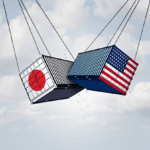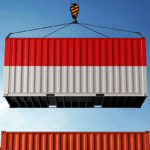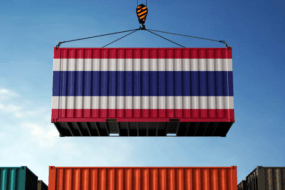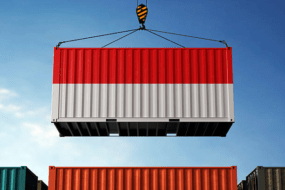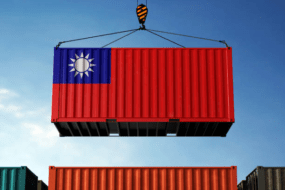- Home
- Trade News
- Japan Imports and Exports Reel ...

It’s been a few months for Japan’s trade sector, and anyone watching the headlines might wonder: Is this just another bump in the road, or the start of something bigger?
In 2025, the United States introduced a fresh round of tariffs targeting Japanese goods: 25% on motor vehicles and 24% on select imports. Tokyo’s response has been cautious, but much more is unfolding beneath the surface.
Japan’s imports and exports have certainly felt the pressure. Auto shipments to the US dropped by nearly a quarter, dragging down overall exports for the first time in eight months.
But rather than panic, Japanese companies have taken a more calculated approach, absorbing the costs, protecting market share, and quietly bracing for the long game. The question is: at what cost?
Japan’s Auto Exports Facing Tariff Pressures
The automotive sector was always going to feel it first. When Washington slapped a fresh 25% tariff on Japanese motor vehicles in April 2025, the impact didn’t take long to show up in the data or factory floors.
Given that Japan’s exports to the United States are heavily dominated by cars, the pressure was immediate, sharp, and politically sensitive.
While some were hopeful this would be short-lived political theatre, what’s playing out appears more structural. This isn’t just a trade spat. It’s a shake-up of longstanding supply chains.
Japan’s Car Export Challenges to the US
In May 2025, Japanese companies saw a nearly 25% drop in car exports to the US, dragging overall export data into negative territory for the first time in eight months.
The symbolism is impossible to ignore for a country that built its post-World War II industrial miracle on cars. Toyota, Honda, and Nissan have all chosen to absorb the cost for now, keeping sticker prices stable in the US market.
However, while shielding consumers, this strategy has pressured their profit margins. If the tariffs persist, it may become financially untenable. It’s also sparked a domino effect across Japan’s manufacturing sector.
Auto Manufacturers Shifting Production to Other Countries
In the face of this pressure, many Japanese companies quietly do what global firms often do when tariffs bite: move production elsewhere. Mexico, Thailand, and even South Korea have become fallback locations for assembly plants targeting the U.S. market.
Manufacturing sector leaders have made it clear: if Washington is going to tax Japan’s exports, those products may as well be made entirely outside Japanese cities.
That presents a different kind of risk for Japan: economic leakage. While this might help companies sidestep tariffs in the short term, it could undermine local employment, factory output, and GDP growth in the long run.
While it’s tempting to label this a one-off adjustment, it may be part of a broader trend. As more countries seek to renegotiate their trade deals with the U.S., the automotive sector is becoming a testing ground for how much global trade has changed.
Japanese Electronics and Machinery Hit by US Tariffs
Beyond autos, Japan’s export pain also spreads to its high-tech backbone. Japanese electronics and electrical machinery companies are grappling with rising costs, disrupted demand, and shifting trade preferences.
Electrical Machinery and Consumer Electronics Facing Setbacks
The electronics sector, long considered one of Japan’s main export partners, is now under growing pressure.
After the automotive industry, electrical machinery and consumer electronics represent a core component of Japan’s exports, particularly to the US, where demand for Japanese-made semiconductors, cameras, sensors, and home appliances has remained high.
But with the latest wave of US tariffs, a sector already squeezed by supply chain disruptions and rising input costs is now confronting a different challenge: market access.
While Japan has previously benefited from its reputation for reliability and advanced technology, even brand equity can’t offset a 20–24% price markup caused by protectionist policy.
Manufacturers like Sony, Panasonic, and Hitachi are now exploring options to restructure their export mix by diverting shipments to developed countries like Germany and Canada or accelerating partnerships across Southeast Asia, where tariff regimes are more favourable.
Meanwhile, U.S. importers, especially in retail and tech distribution, are beginning to look to South Korea, Taiwan, and even Mexico for alternatives.
Japan’s Energy Imports Under Tariff Strain
Japan’s heavy reliance on imported energy has always been a strategic vulnerability, exposing it to the fluctuations of global commodity markets. In 2025, this inherent fragility is being tested by renewed global trade tensions and the ongoing volatility in international energy prices.
Higher Costs for Liquefied Natural Gas and Petroleum Oils in a Strained Global Market
As a nation heavily dependent on imported energy, Japan has always been exposed to price shocks in global commodity markets.
While the newly announced 25% U.S. tariffs are primarily levied on Japanese goods exported to the United States, the broader climate of heightened protectionism and trade disputes contributes to global economic uncertainty.
This environment, alongside geopolitical factors, can indirectly influence international energy markets, leading to increased volatility and potentially higher procurement costs for essential fuels like liquefied natural gas (LNG) and petroleum oils.
Given Japan’s lack of natural resources, its energy security has always been fragile. Nearly 90% of the country’s energy supply is imported. While renewables are gaining traction, natural gas and oil still power a significant chunk of households and industry.
Japanese buyers face challenges securing stable and affordable energy supplies in this complex global trade landscape. This can lead to competitive bidding in global markets, where prices may be influenced by overall market instability and the diversion of supplies, rather than direct tariffs on Japan’s energy imports.
Japan’s Response to Imported Energy Challenges
Faced with these realities, the Japanese government has started to act. The Ministry of Economy, Trade and Industry (METI) has fast-tracked incentives for LNG diversification, expanding import terminals and striking new agreements with countries such as Qatar, Australia, and Malaysia.
One recent move was the reactivation of long-dormant talks with Canada on nuclear cooperation and energy shipping routes through the Arctic, highlighting how broad Japan’s playbook is becoming.
There’s also renewed momentum in the transition to clean energy. Just as Singapore’s Green Plan 2030 outlines a roadmap for energy resilience, Japan is pouring billions into hydrogen, offshore wind, and battery storage.
While these alternatives won’t solve the problem overnight, they may cushion Japan from future natural gas and oil tariff-related shocks.
In parallel, firms like JERA and TEPCO have been instructed to reduce reliance on single-source suppliers and prioritise long-term contracts that offer stable pricing, even if that means paying slightly more upfront.
Japan’s Economy Feeling the Effects of Tariffs
The broader economic ripple becomes harder to ignore as the U.S. tariffs sink deeper into Japan’s export-dependent industries. While short-term fixes may soften the blow, the structural pressures on Japan’s economy are mounting, and 2025 could be a pivotal year shaping its long-term trajectory.
Trade Balance and Economic Growth Outlook
The most immediate red flag has been Japan’s deteriorating trade balance. With total exports slowing, particularly in motor vehicles, consumer electronics, and electrical machinery, and imports becoming more expensive due to global energy volatility, Japan is again facing a widening trade deficit.
Recent economic indicators show that the trade balance has consistently been in deficit in some recent quarters of 2025, particularly as imported energy costs surged.
Meanwhile, institutions like the World Bank have revised downward GDP projections. In its June 2025 report, the Bank lowered its 2025 growth estimate for Japan’s gross domestic product to 0.7% in inflation-adjusted real terms, compared to its earlier forecast of 1.2%.
Other forecasts, such as from the Dai-ichi Life Research Institute, similarly project around 0.7% for calendar year 2025, with potential for near-flat growth excluding carryover effects.
Some argue that this slowdown is cyclical, tied to global cooling across major markets. But there’s a growing consensus that the current tariffs, and the strategic shifts they’re forcing, could mark a more structural change to how Japan grows and trades.
These tariffs are expected to negatively affect the Japanese economy through several channels, including declining exports to the U.S., reduced investment due to rising uncertainty, and deteriorating corporate sentiment.
Weaker Yen Impacting Trade and Inflation
Under different circumstances, a weaker yen would be welcome news for exporters. But in today’s climate, the currency’s depreciation does more harm than good.
While a soft yen makes Japan’s exports more competitive, U.S. tariffs and higher import data costs, especially for essentials like liquefied natural gas, petroleum oils, and raw materials, cancel this benefit.
On the flip side, the weak yen is inflating the cost of imports, raising the price of everyday goods for Japanese people. From groceries to fuel, the inflationary effects are being felt across households, prompting some economists to warn of a scenario where Japan ends up with “imported inflation” but no meaningful export recovery.
The Bank of Japan remains cautious about raising interest rates, fearing it could stifle fragile consumer demand and wages. This puts Tokyo in a tricky bind: let the yen slide and absorb rising costs, or intervene at the risk of choking off growth.
Factory Output, Wages, and Consumer Demand Slowing
As one would expect, the macro effects of these pressures are filtering down into Japan’s manufacturing sector. Factories in key Japanese cities, from Nagoya to Fukuoka, report slower output, reduced overtime, and project delays.
Industrial production data for May 2025 showed a modest 0.5% increase month-on-month, significantly missing analyst expectations of a much higher gain. Sectors tied to transport equipment (excluding cars), chemical products, and electronic equipment were among the hardest hit, indicating a broad slowdown in manufacturing output.
Meanwhile, while nominal wage growth (average cash earnings) has continued to rise, reaching around 1.0% year-on-year in May 2025 (and higher for spring wage negotiations), real wages (adjusted for persistent inflation) have remained sluggish.
In fact, real wages fell by 2.9% year-on-year in May 2025, marking the fifth consecutive monthly decline and the sharpest drop in nearly two years. This erosion of purchasing power is a critical concern for consumer demand.
After some earlier contractions, household spending showed a significant rebound, jumping 4.7% year-on-year in May 2025. This was the fastest growth since August 2022, primarily driven by surges in spending on durable goods like automobiles and increased outlays for transportation and recreation.
However, despite this uptick, the psychological impact of rising overall living costs and unstable trade flows continues to cause many Japanese households to remain cautious.
Japanese Government’s Trade and Policy Response
As key export sectors buckle under the weight of rising tariffs and inflation eats into household confidence, Tokyo is under increasing pressure to demonstrate both economic leadership and diplomatic tact.
Diplomatic Efforts to Negotiate with the US
First came the diplomacy. In June and July 2025, Prime Minister Shigeru Ishiba and top trade envoys held quiet but urgent meetings with U.S. officials in Washington and New York.
While public statements remain vague, insiders say Japan is pressing hard for exemptions or phased relief on high-value categories like motor vehicles, electronic equipment, and food products.
Some in Tokyo had initially hoped that Washington’s measures might be softened through the multilateral route, perhaps through G7 channels or ASEAN cooperation.
However, with the U.S. doubling down on its “reciprocal tariff” strategy, the Ishiba administration appears to be shifting tactics, focusing instead on securing bilateral carve-outs.
Interestingly, there’s also been talk of reviving some form of a digital trade framework involving developed countries, aimed at insulating goods and services like cloud software, e-commerce platforms, and IP licensing from future tariff regimes.
But so far, the mood has been cautious. As other countries line up to renegotiate their deals with Washington, reportedly over 50 at the time of writing, Japan risks being lost in the shuffle unless it pushes more aggressively or offers stronger incentives.
Japan’s Financial Measures to Support Affected Industries
While the diplomacy continues, the Japanese government has also begun deploying domestic tools to cushion the blow at home. In late May, the Cabinet approved a significant relief package, reported to be around ¥900 billion (approx. US$6.3 billion), targeting major industries impacted by the tariff hikes.
This includes temporary subsidies for exporters of transport equipment, tax relief for small and mid-sized manufacturers, and low-interest credit for firms facing sudden losses due to cancelled U.S. contracts.
The package also includes targeted grants for energy-intensive businesses, particularly those affected by rising imported energy costs, such as liquefied natural gas and petroleum oils.
Additionally, funds have been earmarked for R&D programmes in advanced technology, aiming to push innovation in robotics, automation, and clean energy as future growth pillars.
But here’s the catch: many observers feel this may not be enough. Relief funds are stopgaps, not solutions. Industries are asking for long-term clarity on Japan’s trade agreement strategy, fiscal planning, and how the government plans to balance trade resilience with open market principles.
Some economists have suggested following Singapore’s lead and building a stronger public-private framework for trade intelligence, infrastructure modernisation, and SME financing.
Shifts in Japan’s Manufacturing and Investment Strategy
As Japan navigates the ongoing tariff storm, it’s becoming increasingly clear that the country is starting to restructure its trade and investment strategy. And while some adjustments are reactive, others signal a deeper evolution in how Japanese companies operate, invest, and deliver goods and services globally.
Manufacturing Sector Adjustments Amid Tariff Risks
If there’s one constant in the Japanese manufacturing sector, it’s precision. But even precision must adapt. Since the imposition of US tariffs in early 2025, many firms have begun rethinking their production geography, not abandoning domestic factories entirely, but diversifying where possible.
Some of Japan’s largest exporters, Mitsubishi, Denso, and Yamaha, are exploring hybrid models: retaining core manufacturing in major Japanese cities for high-value, low-volume items while moving bulk production of price-sensitive components to other Southeast Asian countries.
Vietnam and Thailand, in particular, are emerging as go-to hubs due to competitive labour costs, bilateral tax treaties, and growing regional demand.
This reshoring-plus-offshoring model allows firms to lower their exposure to tariff risks without fully decoupling from domestic employment and R&D ecosystems.
Changes in Foreign Direct Investment and Services Trade
Alongside factory moves, there’s another telling shift taking place: the direction of foreign direct investment (FDI). Instead of simply receiving capital from abroad, Japanese companies are increasingly deploying funds outward, particularly into neighbouring countries with favourable tariff structures and growing middle-class demand.
Meanwhile, Japan’s traditionally understated services trade is quietly gaining traction. Legal, design, consultancy, and cloud-based services, once a peripheral export category, are now bundled into larger deals combining physical goods and services.
This shift could become one of the defining trends of the next decade. As goods move more slowly, are more expensive, and are under tighter scrutiny, digital and intangible services may allow Japan to remain competitive without physically shipping as much product.
Of course, this won’t happen overnight. However, with the right incentives and trade facilitation policies, Japan could gradually transition from being known simply as a powerhouse of physical exports to a reliable partner for integrated, tech-driven trade solutions.
Key Export Markets and Trade Partnerships for Japan
The country’s ability to maintain and deepen relationships with nearby Asian economies could be the key to weathering external shocks and avoiding overreliance on any single market.
Export Relations with China, South Korea, and Taiwan
Despite diplomatic tensions, China remains one of Japan’s main export partners. Exports of electronic equipment, chemical products, and high-grade raw materials continue to flow between the two nations, even if demand has recently cooled due to China’s economic slowdown.
The relationship with South Korea is complex but mutually beneficial. Japan supplies critical components, such as semiconductors and precious metals, to South Korean tech giants while importing refined materials and consumer electronics.
Although both countries compete in global markets, they rely on each other’s industrial ecosystems. Taiwan, meanwhile, has emerged as a strategic partner, especially in advanced technology and semiconductors.
Joint R&D initiatives and dual investments in green manufacturing hubs indicate a growing synergy beyond basic trade. What unites all three is a shared interest in regional stability, streamlined logistics, and secure digital infrastructure.
Japan’s Trade Strategies With Developed Countries
Looking further afield, Japan is also refining its approach to developed countries beyond the U.S. In the EU, Japan’s Economic Partnership Agreement has enabled tariff-free trade for many goods and services, helping to mitigate some of the disruption caused by U.S. tensions.
The UK and Australia are also rising in importance. Japan’s exports of motor vehicles and other machinery and transport equipment have increased to both nations, partly due to new trade agreements signed post-Brexit (for the UK) and under the Comprehensive and Progressive Agreement for Trans-Pacific Partnership (CPTPP), of which Japan is a key member.
Conclusion: What’s Next for Japan’s Trade in a Fragmenting World
The story of Japan imports and exports in 2025 is a simultaneous disruption and reinvention. The shock of U.S. tariffs has hit hard, especially in motor vehicles, consumer electronics, natural gas, and petroleum oils, and Japan’s trade balance has teetered as a result.
But this is no longer just about defence. It’s about recalibrating the very foundation of Japan’s economy. As the global system fractures and reforms, Japan must assert itself as a physical goods manufacturer and a provider of secure supply chains, smart technology, and sustainable trade ecosystems.
And to navigate this new landscape, real-time trade intelligence is a necessity. If you want to stay ahead of the shifts shaping Japan and the broader global market, visit TradeDataPro for the tools you need to monitor import data, spot market trends, and make informed, timely decisions.


